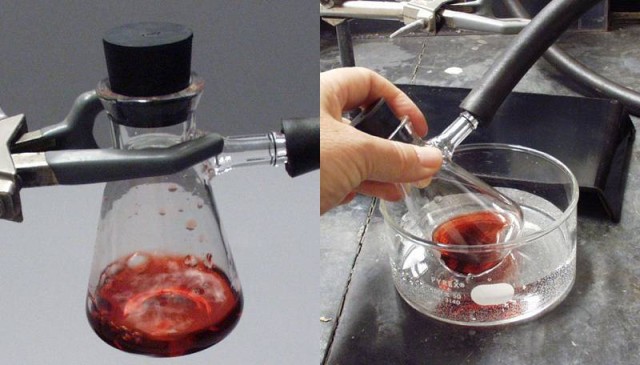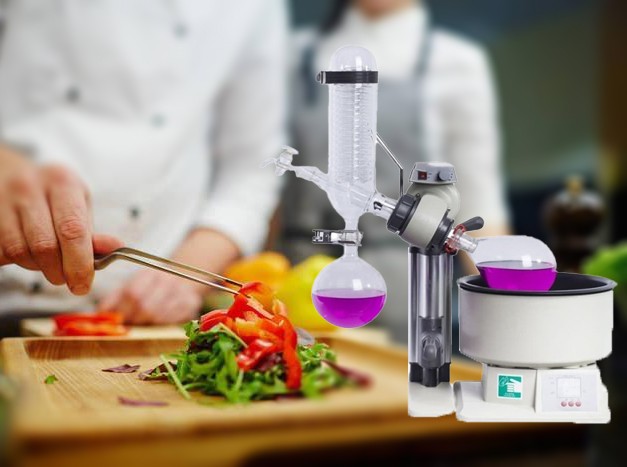Introduction: Explanation of Rotary Evaporator for Cooking
A rotary evaporator, also known as a rotovap, is a laboratory equipment used for distillation. It is a device that rotates the sample under reduced pressure, which allows for the evaporation of solvents. In recent years, the rotovap has gained popularity in the culinary world, where chefs use it to create unique flavors and textures in their dishes. The rotovap offers many benefits for cooking, such as preserving delicate aromas, enhancing flavors, and creating a more concentrated and intense taste. The device can be used for a wide range of applications, including creating infused oils, distilling spirits, and making flavored syrups. Overall, the rotovap is an innovative tool that has revolutionized the way chefs approach cooking.
Table of Contents
Benefits of Cooking with a Rotary Evaporator
Cooking with a rotary evaporator is a new and innovative way to enhance your dishes. This technology allows for precise control over temperature and pressure, resulting in several benefits that make it an exciting tool for chefs and home cooks alike.

Preserving Delicate Flavors
One of the main benefits of using a rotary evaporator for cooking is the ability to preserve delicate flavors. By using a vacuum evaporation technique, the process can be carried out at lower temperatures, ensuring that the original performance of the food material is maintained. This allows for the extraction and concentration of the flavors of even the most delicate of ingredients, such as herbs and flowers, resulting in intense and complex flavors that are not lost during the cooking process.
Unique Textures and Consistencies
Another benefit of cooking with a rotary evaporator is the ability to create unique textures and consistencies. By using a rotating feature of the evaporating flask, it increases the surface area for evaporation, resulting in faster evaporation rates. This allows for the creation of unique textures and consistencies such as foams and gels, which can add a touch of creativity and sophistication to your dishes.
Versatile Tool for Any Kitchen
A rotary evaporator can be used for both sweet and savory dishes, making it a versatile tool in any kitchen. This technology allows for the separation of food components from one another without affecting any of the food components. This makes it an ideal and more popular tool for home cooking.

Gentle and Precise Cooking
Rotary evaporator cooking involves the use of evaporation and distillation at lower temperatures, making it safe and beneficial for human consumption. This ensures that the food is gently cooked while maintaining its taste, aroma, and nutritional value. The heating source of a rotary evaporator is a heated water bath or oil bath, which involves immersing the evaporating flask into the hot bath. This increases the surface area of the mixture, thereby increasing the rate of distillation.
Easy to Monitor and Adjust
Rotary evaporator cooking allows for visual monitoring and adjustment of the process. A rotary evaporator consists of transparent glass hardware, allowing the user to visually see the completion of the evaporation process. This eliminates the guesswork and allows for precise control over the temperature and pressure.
Wastage-Free and Efficient
Another benefit of using a rotary evaporator for cooking is that it is a wastage-free and efficient process. The totally sealed glass hardware ensures that no wastage or leakage of the mixture occurs. This ensures 100% component recovery, making it an efficient and cost-effective way of cooking.
In conclusion, cooking with a rotary evaporator has several benefits, including preserving delicate flavors, creating unique textures, and consistencies, versatility, gentle and precise cooking, easy monitoring, and adjustment, and being wastage-free and efficient. These benefits make it an exciting and innovative tool for chefs and home cooks looking to enhance their culinary skills and create flavorful, creative, and unique dishes.
Applications of a Rotary Evaporator in Cooking
A rotary evaporator is a laboratory equipment that has found its way into the culinary world. It is becoming increasingly popular among home cooks who want to take their cooking to the next level. By applying vacuum pressure and low heat, a rotary evaporator can extract and isolate the essential oils, aromas, and flavors from herbs, fruits, and other ingredients, resulting in highly potent and concentrated extracts. Here are some applications of a rotary evaporator in cooking:

Concentrating Juices
One of the most common applications of a rotary evaporator in cooking is to concentrate juices. With a rotary evaporator, people can easily concentrate all kinds of juice by removing water. The juice concentrated can possess a much better taste.
Extracting Flavors
A rotary evaporator can also be used to extract flavors from a blend of alcohol, herbs, and fruit. This method is done at very low temperatures, which helps to preserve the original taste of the ingredients. By extracting and isolating the essential oils, aromas, and flavors, one can create concentrated extracts, which can be used to enhance the taste of dishes, add unique flavors to cocktails or even create new signature dishes.
Separating Compounds
Because the complex composition of food samples, proteins, fats, and sugars often cause interference in analysis and detection, a rotary evaporator is often used for treatment in advance. Rotary evaporator cooking is also used for the separation of acids, sugars, colors, and bitter compounds from alcohols, flavor molecules, aromas among others.
Making Homemade Liquors
Rotary evaporator cooking is also used to cook homemade aquavit and chocolate liquor by mixing chocolate liquid and vodka. The rotary evaporator is used to remove the water from the mixture, leaving behind a concentrated liquor that has a stronger taste.
Extracting Aromas
A rotary evaporator can be used to extract herb aromas like basil. For example, a chef may use a rotary evaporator to create a basil-infused oil to drizzle over a caprese salad, or to extract the aroma of coffee beans to use in a dessert.

In conclusion, cooking with a rotary evaporator has a great variety of merits. The applications of a rotary evaporator in cooking are vast and varied, and it is an exciting tool for cooks looking to experiment with new flavors and techniques in the kitchen.
Working Principle of a Rotary Evaporator
A rotary evaporator is a laboratory equipment used for vacuum distillation to remove solvents from a sample. It works by rotating a flask containing the sample under reduced pressure, which causes the liquid to evaporate and collect in a separate flask. In this section, we will discuss the working principle of a rotary evaporator in detail.
Vacuum System
The vacuum system is an essential component of a rotary evaporator. It creates a vacuum space in the rotary glass flask, which lowers the boiling point of the solvent in question. The solvent vapor is then cooled by the glass condenser and recovered in the collection bottle, which greatly improves the evaporation efficiency.
Heating System
The heating system consists of a heated water or oil bath that indirectly passes heat to the process feed inside the flask. As the process feed gets heated, the low boiler converts into vapors and goes up the vapor tube and into the condenser, where the condensate is formed. This condensate can either be refluxed back into the rotary flask for higher purity applications or collected in the receiver.
Rotating Flask
The rotating flask is another important component of a rotary evaporator. It is designed to rotate at a constant speed, and the material forms a large-area film on the bottle wall and evaporates. The rotation mechanism also makes it suitable for volatile and heat-sensitive process media, wherein the properties can alter if direct high heat is applied for a longer time.

Condenser
The condenser plays a crucial role in the working principle of a rotary evaporator. The condenser is a glass tube that is cooled by a cooling medium like water or air. It helps to convert the vapor back into a liquid, which is then collected in the receiver.
Collection Bottle
The collection bottle is the final component of a rotary evaporator. It is where the solvent is collected after it has been condensed. The collection bottle can be used to collect the solvent for reuse or dispose of it as per the laboratory's waste disposal policy.
In conclusion, the working principle of a rotary evaporator involves the use of vacuum distillation to remove solvents from a sample. It works by rotating a flask containing the sample under reduced pressure, which causes the liquid to evaporate and collect in a separate flask. The vacuum system, heating system, rotating flask, condenser, and collection bottle are the essential components of a rotary evaporator that work together to achieve this process.

Conclusion: Summary of Rotary Evaporator Cooking
In summary, cooking with a rotary evaporator is an innovative technique that offers a range of benefits. By using a rotovap, chefs can enhance the flavor and aroma of their dishes, creating unique and exciting culinary experiences for their guests. This technology can be used to create a wide range of products, from infusions and reductions to distillates and concentrates. Compared to traditional distillation methods, the primary advantage of a rotary evaporator is its efficiency, allowing for faster and more precise extraction. Overall, the rotary evaporator is an exciting tool for chefs who are looking to push the boundaries of their craft and create new and exciting dishes.
